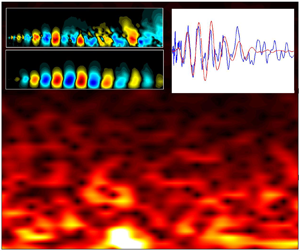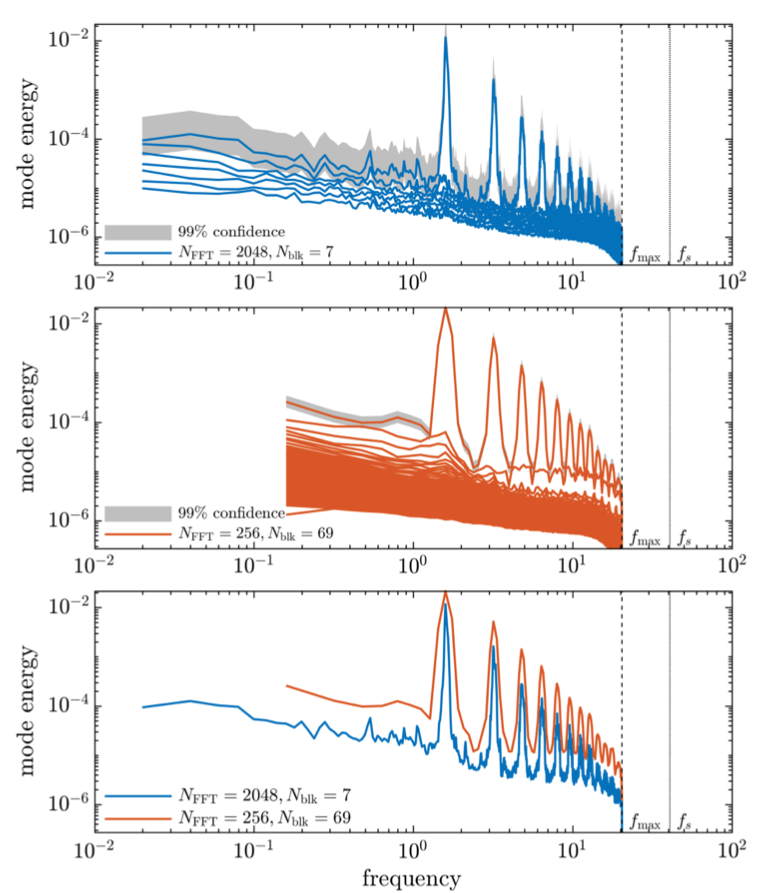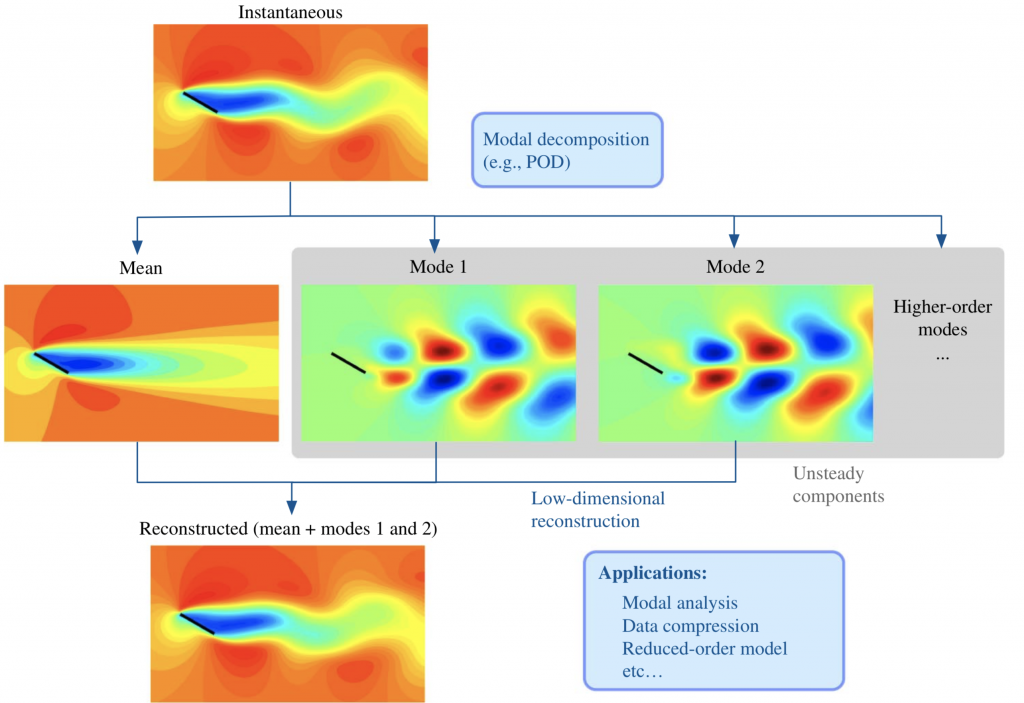@Article{schmidtetal_2019_mwr,
author = {Schmidt, O. T. and Mengaldo, G. and Balsamo, G. and Wedi, N. P.},
journal = {Monthly Weather Review},
title = {Spectral Empirical Orthogonal Function Analysis of Weather and Climate Data},
year = {2019},
number = {8},
pages = {2979-2995},
volume = {147},
abstract = {We apply spectral empirical orthogonal function (SEOF) analysis to educe climate patterns as dominant spatiotemporal modes of variability from reanalysis data. SEOF is a frequency-domain variant of standard empirical orthogonal function (EOF) analysis, and computes modes that represent the statistically most relevant and persistent patterns from an eigendecomposition of the estimated cross-spectral density matrix (CSD). The spectral estimation step distinguishes the approach from other frequency-domain EOF methods based on a single realization of the Fourier transform, and results in a number of desirable mathematical properties: at each frequency, SEOF yields a set of orthogonal modes that are optimally ranked in terms of variance in the L2 sense, and that are coherent in both space and time by construction. We discuss the differences between SEOF and other competing approaches, as well as its relation to dynamical modes of stochastically forced, nonnormal linear dynamical systems. The method is applied to ERA-Interim and ERA-20C reanalysis data, demonstrating its ability to identify a number of well-known spatiotemporal coherent meteorological patterns and teleconnections, including the Madden–Julian oscillation (MJO), the quasi-biennial oscillation (QBO), and the El Niño–Southern Oscillation (ENSO) (i.e., a range of phenomena reoccurring with average periods ranging from months to many years). In addition to two-dimensional univariate analyses of surface data, we give examples of multivariate and three-dimensional meteorological patterns that illustrate how this technique can systematically identify coherent structures from different sets of data. The MATLAB code used to compute the results presented in this study, including the download scripts for the reanalysis data, is freely available online.},
doi = {10.1175/MWR-D-18-0337.1},
eprint = {https://doi.org/10.1175/MWR-D-18-0337.1},
file = {:SchmidtEtAl_2019_MWR.pdf:PDF},
url = {https://doi.org/10.1175/MWR-D-18-0337.1},
}
 Four different applications of spectral proper orthogonal decomposition (SPOD) are demonstrated on large-eddy simulation data of a turbulent jet. These are: low-rank reconstruction, denoising, frequency–time analysis and prewhitening. We demonstrate SPOD-based flow-field reconstruction using direct inversion of the SPOD algorithm (frequency-domain approach) and propose an alternative approach based on projection of the time series data onto the modes (time-domain approach). We further present a SPOD-based denoising strategy that is based on hard thresholding of the SPOD eigenvalues. The proposed strategy achieves significant noise reduction while facilitating drastic data compression.
Four different applications of spectral proper orthogonal decomposition (SPOD) are demonstrated on large-eddy simulation data of a turbulent jet. These are: low-rank reconstruction, denoising, frequency–time analysis and prewhitening. We demonstrate SPOD-based flow-field reconstruction using direct inversion of the SPOD algorithm (frequency-domain approach) and propose an alternative approach based on projection of the time series data onto the modes (time-domain approach). We further present a SPOD-based denoising strategy that is based on hard thresholding of the SPOD eigenvalues. The proposed strategy achieves significant noise reduction while facilitating drastic data compression.![]()
 The use of spectral proper orthogonal decomposition (SPOD) to construct low-order models for broadband turbulent flows is explored. The choice of SPOD modes as basis vectors is motivated by their optimality and space-time coherence properties for statistically stationary flows. This work follows the modeling paradigm that complex nonlinear fluid dynamics can be approximated as stochastically forced linear systems. The proposed stochastic two-level SPOD-Galerkin model governs a compound state consisting of the modal expansion coefficients and forcing coefficients. In the first level, the modal expansion coefficients are advanced by the forced linearized Navier-Stokes operator under the linear time-invariant assumption. The second level governs the forcing coefficients, which compensate for the offset between the linear approximation and the true state. At this level, least squares regression is used to achieve closure by modeling nonlinear interactions between modes.
The use of spectral proper orthogonal decomposition (SPOD) to construct low-order models for broadband turbulent flows is explored. The choice of SPOD modes as basis vectors is motivated by their optimality and space-time coherence properties for statistically stationary flows. This work follows the modeling paradigm that complex nonlinear fluid dynamics can be approximated as stochastically forced linear systems. The proposed stochastic two-level SPOD-Galerkin model governs a compound state consisting of the modal expansion coefficients and forcing coefficients. In the first level, the modal expansion coefficients are advanced by the forced linearized Navier-Stokes operator under the linear time-invariant assumption. The second level governs the forcing coefficients, which compensate for the offset between the linear approximation and the true state. At this level, least squares regression is used to achieve closure by modeling nonlinear interactions between modes.![[PDF]](https://flowphysics.ucsd.edu/wp-content/plugins/papercite/img/pdf.png)
 Triadic interactions are the fundamental mechanism of energy transfer in fluid flows. Bispectral mode decomposition (BMD) educes coherent flow structures that are associated with triadic interactions from experimental or numerical data. Triadic interactions are characterized by quadratic phase coupling which can be detected by the bispectrum. The proposed method maximizes an integral measure of this third-order statistic to compute modes associated with frequency triads, as well as a mode bispectrum that identifies resonant three-wave interactions. Unlike the classical bispectrum, the decomposition establishes a causal relationship between the three frequency components of a triad. This permits the distinction of sum- and difference-interactions, and the computation of interaction maps that indicate regions of nonlinear coupling.
Triadic interactions are the fundamental mechanism of energy transfer in fluid flows. Bispectral mode decomposition (BMD) educes coherent flow structures that are associated with triadic interactions from experimental or numerical data. Triadic interactions are characterized by quadratic phase coupling which can be detected by the bispectrum. The proposed method maximizes an integral measure of this third-order statistic to compute modes associated with frequency triads, as well as a mode bispectrum that identifies resonant three-wave interactions. Unlike the classical bispectrum, the decomposition establishes a causal relationship between the three frequency components of a triad. This permits the distinction of sum- and difference-interactions, and the computation of interaction maps that indicate regions of nonlinear coupling.
 The mechanics of extreme intensity events in the buffer and logarithmic layers of a turbulent channel at 𝑅𝑒𝜏=2000 is investigated. The 99.9th percentile of the most intense events in the dissipation of turbulent kinetic energy is analysed by means of conditional space–time proper orthogonal decomposition. The computed spatio-temporal modes are coherent in space and over the considered time frame, and optimally capture the energy of the ensemble. The most energetic mode with transverse symmetric structure describes a turbulent burst event. The underlying mechanism is a varicose instability which generates localized extrema in the dissipation and production of turbulent kinetic energy and drives the formation of a hairpin vortex. The most energetic anti-symmetric mode is related to a sinuous-type instability that is situated in the shear layer between two very-large-scale streaks. Statistical results show the energy in the symmetric mode to exceed that in the anti-symmetric mode by a near constant factor for the considered wall distances. Both mechanisms occur throughout the range of wall distances in an effectively self-similar manner that is consistent with the attached-eddy hypothesis. By analogy with transitional flows, the results suggest that the events are induced by an exponential growth mechanism.
The mechanics of extreme intensity events in the buffer and logarithmic layers of a turbulent channel at 𝑅𝑒𝜏=2000 is investigated. The 99.9th percentile of the most intense events in the dissipation of turbulent kinetic energy is analysed by means of conditional space–time proper orthogonal decomposition. The computed spatio-temporal modes are coherent in space and over the considered time frame, and optimally capture the energy of the ensemble. The most energetic mode with transverse symmetric structure describes a turbulent burst event. The underlying mechanism is a varicose instability which generates localized extrema in the dissipation and production of turbulent kinetic energy and drives the formation of a hairpin vortex. The most energetic anti-symmetric mode is related to a sinuous-type instability that is situated in the shear layer between two very-large-scale streaks. Statistical results show the energy in the symmetric mode to exceed that in the anti-symmetric mode by a near constant factor for the considered wall distances. Both mechanisms occur throughout the range of wall distances in an effectively self-similar manner that is consistent with the attached-eddy hypothesis. By analogy with transitional flows, the results suggest that the events are induced by an exponential growth mechanism.



